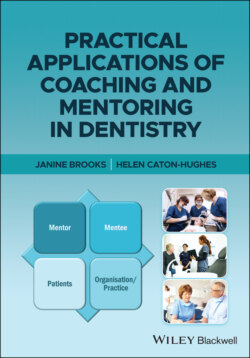Читать книгу Practical Applications of Coaching and Mentoring in Dentistry - Janine Brooks - Страница 14
What's Inside This Book
ОглавлениеHaving outlined some key differences between interventions we can move onto think about how the book is structured.
Chapter 2 provides an outline of the mechanics of mentoring. This is an opportunity to consider the who and why of mentoring. The characteristics of mentoring and being a mentor are reviewed. We explore what mentoring can achieve and the different types of mentoring. There is a section on criteria that can help when choosing a mentor. The ethics of mentoring are also an important consideration in this chapter.
Chapter 3 reviews coaching: looking at what we mean by coaching, including definitions from the major coaching bodies. It also looks at some of the underpinning ideas or theories that inform coaching and which distinguishes this type of conversation from others, including differences between ‘mentoring’ and ‘coaching’. This theory is applied through the practical skills covered in the following chapter.
Chapter 4 considers models used within mentoring and coaching with particular emphasis on the Forton model which is used extensively in our qualifications.
Chapter 5 is the key focus of the book, the case studies. Here we include 12 case studies generously provided by each of our contributors. The case studies are real examples of how to use mentoring practically within dentistry in the UK. The studies have been grouped into five categories which include: dentists in difficulty; evaluation; early years – undergraduates, foundation dentists, and post foundation; general practice; and organisational culture and models/tools. They showcase the diversity of using mentoring alongside mentoring tools and related techniques.
Chapter 6 covers discussion and conclusions. In this final chapter we review some of the lessons learned from the case studies and important themes that thread through. Communication is an aspect that can be found across the case studies and the categories of study. We look at some myths around mentoring and attempt to bust those myths. Looking beyond 1 : 1 mentoring is discussed as we consider team mentoring. Boundaries and barriers to mentoring also figure in the discussion and we conclude with a call for more case study contributions, to build on the body of knowledge, and with pointers for the way forward for coaching and mentoring in dentistry.
